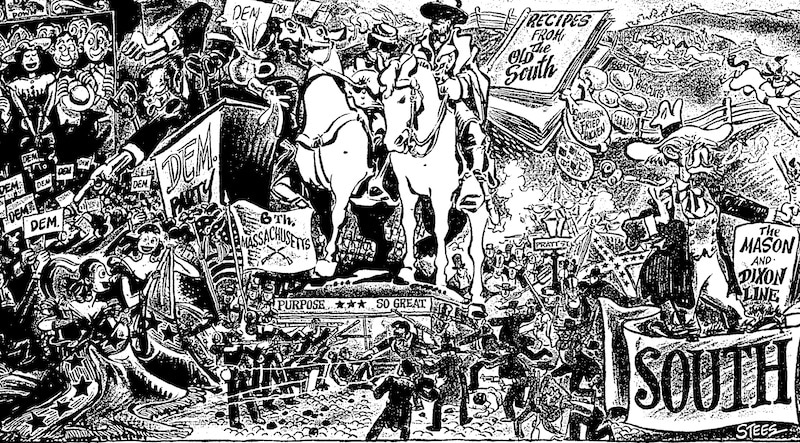|
"Baltimore is a Southern City," September, 1948.
At 2pm, 300 Virginia Military Institute cadets, members of the 175th Infantry, Maryland National Guard in their full-dress uniforms, and the Army Ground Forces Band marched from Charles and 22nd street up Charles street to Art Museum Drive, then “halted in front of that building. There was a pause while the guests were seated.”
"Hawkers peddled Confederate flags, sales being fairly good at $1 a flag. Chairs were lined up in front and on either side of the monument. A grandstand was opposite the memorial.” 3,000 people were in attendance, and in the Freeman recording, you can hear honking of cars in the background. At 3pm, the speeches started. The schedule included: an introduction, the National Anthem, introductory remarks, introduction of Governor of Maryland, a tribute to J.H. Ferguson, introduction of sculptor, introduction of representatives of the armed forces, introduction of Dr. Freeman, Dr. Freeman's speech, an acceptance by the Mayor, the laying of a wreath, and a final benediction. If some crackpot with a diseased brain should leave the city a few thousand dollars with which to erect a memorial to Benedict Arnold, there are probably some church, city and state officials who could persuaded by the daughters of the American Revolution to build it, and to orate at it’s dedication. -Baltimore Afro-American, May 15, 1948
The Afro-American has the most serious critique of the statue, the event, and the other speeches that were given the day of the dedication.
We must remain steadfast in our determination to preserve freedom, not only for ourselves, but for the other liberty-loving nations....Today, with our nation beset by subversive groups and propaganda which seeks to destroy our national unity, we can look for inspiration to the lives of Lee and Jackson to remind us to be resolute and determined in preserving the sacred institutions. -Thomas D'Alesandro, Mayor of Baltimore
The Mayor of Baltimore was in attendance, with his family, including an 8-year old Nancy Pelosi. The Afro-American pointed out the "sacred institutions" the Confederacy was interested in preserving was slavery. However, the editorial also wrote, "So far as the mayor is concerned, we know he was merely making a speech. He doesn’t believe in the confederacy stuff."
I do not know but what Mr. Ferguson may have given some thought, too, to the singular appropriateness of erecting in Maryland a monument to two men who best typify the gallantry and statesmanship of the Confederacy....Our might is the sole remaining bulwark on which the free peoples of the world rest their hopes for remaining free....[The monument] is symbolic of our unity of purpose, as a nation, to preserve those things for which our forefathers... have fought. Governor Lane thought that the "scars of the Civil War have long since been healed," even though that was, and is, clearly not true. The Afro-American wrote of the Civil War: "Here were eleven Southern States dictating to the whole United States, much as the Conference of Southern Governors of this day seeks to do.” Lane was President of the Southern Governors' Association, a group that opposed President Truman's civil rights agenda.
This monument is surely one of the most perfect in America. The sheer beauty of the modeling and perfection of the composition left me literally speechless. -Sidney Waugh, President of the National Sculpture Society
Actually, both Lee and Jackson were an example of small town rebels who walked roughshod over humble people in an attempt to build a State on the foundation of slave labor. - Baltimore Afro-American, May 15, 1948
|

